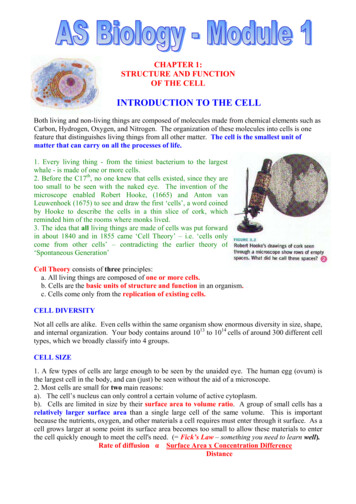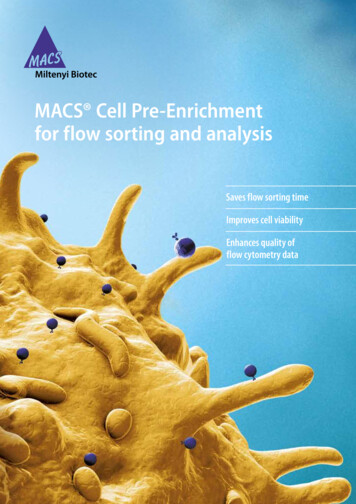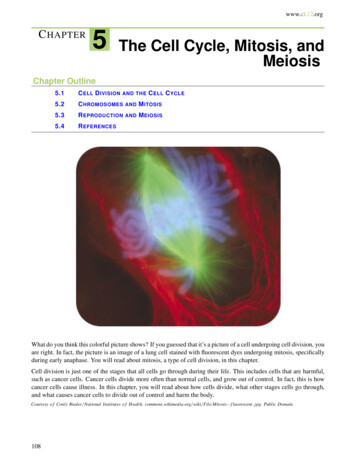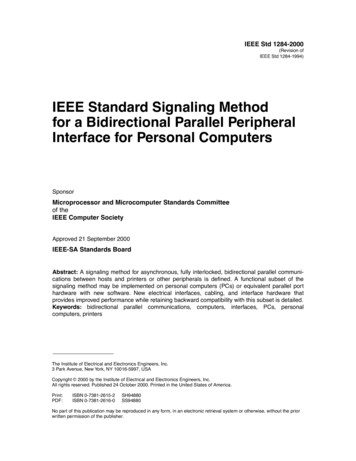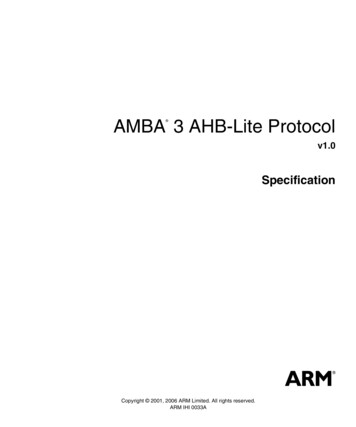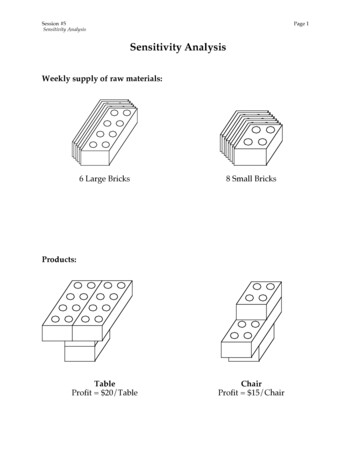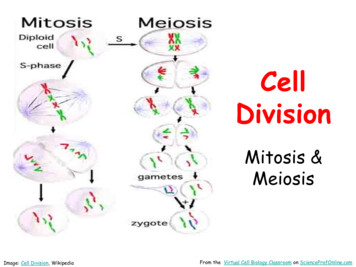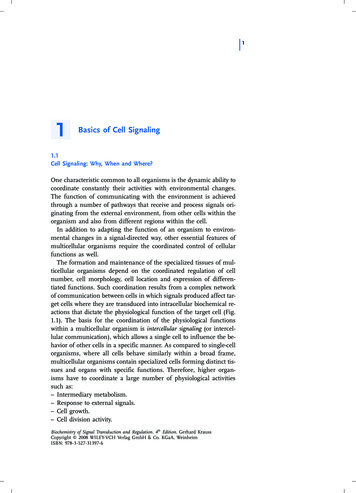
Transcription
11Basics of Cell Signaling1.1Cell Signaling: Why, When and Where?One characteristic common to all organisms is the dynamic ability tocoordinate constantly their activities with environmental changes.The function of communicating with the environment is achievedthrough a number of pathways that receive and process signals originating from the external environment, from other cells within theorganism and also from different regions within the cell.In addition to adapting the function of an organism to environmental changes in a signal-directed way, other essential features ofmulticellular organisms require the coordinated control of cellularfunctions as well.The formation and maintenance of the specialized tissues of multicellular organisms depend on the coordinated regulation of cellnumber, cell morphology, cell location and expression of differentiated functions. Such coordination results from a complex networkof communication between cells in which signals produced affect target cells where they are transduced into intracellular biochemical reactions that dictate the physiological function of the target cell (Fig.1.1). The basis for the coordination of the physiological functionswithin a multicellular organism is intercellular signaling (or intercellular communication), which allows a single cell to influence the behavior of other cells in a specific manner. As compared to single-cellorganisms, where all cells behave similarly within a broad frame,multicellular organisms contain specialized cells forming distinct tissues and organs with specific functions. Therefore, higher organisms have to coordinate a large number of physiological activitiessuch as:– Intermediary metabolism.– Response to external signals.– Cell growth.– Cell division activity.Biochemistry of Signal Transduction and Regulation. 4th Edition. Gerhard KraussCopyright c 2008 WILEY-VCH Verlag GmbH & Co. KGaA, WeinheimISBN: 978-3-527-31397-6
21 Basics of Cell SignalingFig. 1.1: Inter- and intracellularsignaling. The major way ofintercellular communicationuses messenger substances(hormones) that are secretedby signal-producing cells andare registered by target cells.All cells produce and receivemultiple, diverse signals. Theextracellular signals are transduced into intracellular signalingchains that control many of thebiochemical activities of a celland can trigger the formationof further extracellular signals.– Differentiation and development: coordination of expressionprogrammes.– Cell motility.– Cell morphology.Intercellular signaling– Communicationbetween cellsIntracellular signaling– Signaling chains withinthe cell, responding toextracellular and intracellular stimuliSignals generated during intercellular communication must be received and processed in the target cells to trigger the many intracellular biochemical reactions that underlie the various physiologicalfunctions of an organism. Typically, many steps are involved in theprocessing of the signal within the cell, which is broadly describedas intracellular signaling. Signal transduction within the target cellmust be coordinated, fine-tuned and channeled within a networkof intracellular signaling paths that finally trigger distinct biochemical reactions and thus determine the specific functions of a cell. Importantly, both intercellular and intracellular signaling are subjectedto regulatory mechanism that allow the coordination of cellular functions in a developmental- and tissue-specific manner.
1.2 Intercellular Signaling31.2Intercellular SignalingIntercellular signal transduction influences nearly every physiological reaction. It ensures that all cells of a particular type receive andtransform a signal. In this manner, cells of the same type react synchronously to a signal. A further function of intercellular communication is the coordination of metabolite fluxes between cells of various tissues.In higher organisms intercellular signaling pathways have the important task of coordinating and regulating cell division. The pathways ensure that cells divide synchronously and, if necessary, arrestcell division and enter a resting state.Cellular communication assumes great importance in the differentiation and development of an organism. The development of an organism is based on genetic programs that always utilize inter- andintracellular signaling pathways. Signal molecules produced by onecell influence and change the function and morphology of othercells in the organism.Intercellular signaling pathways are also critical for the processingof sensory information. External stimuli, such as optical and acousticsignals, stress, gradients of nutrients, etc., are registered in sensorycells and are transmitted to other cells of the organism via intercellular signaling pathways.1.2.1Tools for Intercellular SignalingWe currently know of various forms of communication between cells(Fig. 1.2):– Extracellular messengers. Cells send out signals in the form of specific messenger molecules that the target cell transmits into a biochemical reaction. Signaling cells can simultaneously influencemany cells by messenger molecules so as to enable a temporallycoordinated reaction in an organism.– Gap junctions. Communication between bordering cells is possiblevia direct contact in the form of “gap junctions”. Gap junctions arechannels that connect two neighboring cells to allow a directexchange of metabolites and signaling molecules between the cells.– Cell–cell interaction via cell surface proteins. Another form of directcommunication between cells occurs with the help of surfaceproteins. In this process a cell surface protein of one cell binds aspecific complementary protein on another cell. As a consequenceof the complex formation, an intracellular signal chain is activatedwhich initiates specific biochemical reactions in the participatingIntercellular signalingcontrols– Metabolic fluxes– Cell division– Growth– Differentiation– Development– Processes sensoryinformation
41 Basics of Cell SignalingFig. 1.2: Principal mechanismsof intercellular communication.(a) Communication via intercellular messengers. (b) Communication via gap junctions. Gapjunctions are direct connectionsbetween cells. They are coatedby proteins (drawn as circles)that can have a regulatory influence on the transport. (c) Communication via surface proteins.Cells communicate via– Messenger substances– Gap junctions– Surface proteins– Electrical signalscells. Communication is then only possible upon direct contactbetween the target cell with the surface protein of the partner cell.– Electrical signaling. A further intercellular communication mechanism relies on electrical processes. The conduction of electricalimpulses by nerve cells is based on changes in the membranepotential. The nerve cell uses these changes to communicate withother cells at specialized nerve endings (synapses). It is central tothis type of intercellular communication that electrical signals canbe transformed into chemical signals. This type of communicationwill not be discussed in this book.In the following, the main emphasis will be on the intercellular communication via extracellular messengers – the hormones.
1.2 Intercellular Signaling51.2.2Steps of Intercellular SignalingIn the communication between cells of an organism, the signals(messengers such as hormones) are produced in specialized cells.The signal-producing function of these cells is itself regulated, sothat the signal is only produced upon a particular stimulus. In thisway signaling pathways can be coupled to one another and coordinated. The following steps are involved in intercellular communication (Fig. 1.3).Formation of a Signal in the Signal-producing Cellas a Result of an External TriggerMost extracellular messengers are produced in response to externaltriggers and are released by exocytosis. Physical stimuli like electricalsignals, changes in ion concentration or, most frequently, other extracellular signaling molecules serve as a trigger to increase the amountof the messenger available for extracellular communication. The me-Fig. 1.3: The individual stepsof intercellular communication.Upon reception of a triggeringstimulus, the signal is transformed into a chemicalmessenger within the signalingcell. The messenger is secretedand transported to the targetcell, where the signal is registered, transmitted further andfinally converted into a biochemical reaction. Not shownare processes of termination orregulation of communicationwhich can act at any of the abovesteps.
61 Basics of Cell Signalingchanisms by which the external trigger signals increase the amountof extracellular messenger are diverse, and include stimulation of thebiosynthesis of the messenger, increased production of the maturemessenger from precursors and release of the messenger from astore form. The latter mechanism is extensively used in the releaseof hormones of the neural system (neurotransmitters) in responseto electrical signals, e.g. at synapses.Steps of intercellularsignaling– Trigger signal inducesrelease of stored messenger or stimulates itsbiosynthesis– Transport to target cell– Receipt of signal by thetarget cell– Conversion of signalinto intracellular signalchain in the target cellTransport of the Signal to the Target CellThe extracellular signal produced may be distributed via the circulation or it may reach the target cell simply by diffusion. In long-rangesignaling via the circulation, the extracellular messenger is oftenbound to specific carrier proteins or incorporated into larger proteincomplexes. This may serve to prevent degradation in the extracellularmedium or to provide for docking to specific cells only. Furthermore,processing or metabolization of a messenger during transport mayconvert it from an inactive form to an active form.Registration of the Signal in the Target CellA target cell that receives a signal within the framework of intercellular communication transmits the signal in intracellular pathways thattrigger distinct biochemical activities in a cell-type-specific mannerand determine the response of the target cell. Specialized proteins,termed receptors, are utilized for the reception of signals in the targetcell. Only those cells that carry the appropriate receptor will be activated for further transduction of the signal into the interior of thecell. The reception of the signals by the receptor is equivalent to thebinding of messenger substance on the receptor or the transmissionof physical stimuli into a structural change in the receptor.There are two principal ways by which target cells can process incoming signals:– Cell surface receptors receive the signal (e.g. a messenger substance) at the outside of the cell, become activated and initiate asignaling chain in the interior of the cell. In such signaling pathways, the membrane-bound receptor transduces the signal at thecell membrane so that it is not necessary for the signal to actuallyenter the cell.– The messenger enters into the target cell and binds and activatesthe receptor localized in the cytosol or nucleus.
1.2 Intercellular Signaling71.2.3Regulation of Intercellular SignalingThe result of communication between the signaling and receivingcells is a defined biochemical reaction in the target cell. The natureand extent of this reaction depends on many individual reactions thatparticipate either directly or indirectly in signal transduction.Beginning with the hormone-producing cell, the following processes are all contributing factors for hormonal signal transductionin higher organisms (Fig. 1.3):– Biosynthesis of the hormone. The enzymes involved in biosynthesisof a hormone can, for example, be controlled by other signal transduction pathways. There may be feedback mechanisms that couplethe activity of the biosynthetic enzymes to the concentration of thecirculating enzyme via allosteric mechanisms.– Degradation and modification of the hormone. The active hormone maybe inactivated by metabolization or inactive hormone precursors maybe converted into the active hormone by enzymatic transformation.– Storage and secretion of the hormone. There are signals (electricalsignals, Ca2 signals) to trigger the secretion of stored hormones.– Transport of the hormone to the target cell. The distribution of ahormone via the circulation contributes to the accessibility of thathormone at a particular location of an organism.– Reception of the signal by the hormone receptor. The hormonereceptors are primarily responsible for the registration of the signaland the further transduction of the signal in intracellular signalingpaths. Therefore, the amount, specificity and activity of receptors ata target cell are major determinants of the final biochemicalreaction in the target cell. We know of several regulatorymechanisms that allow regulation of receptor activity. The receptormay be downregulated in response to the amount of circulatinghormone or intracellular signaling paths may control receptoractivity from inside the cell (Section 5.2.4).All of the above steps are subjected to regulation. A precise control ofthese steps is at the heart of all developmental programs, and wehave gained most information on the control of intercellular communication from developmental studies and from the failure of the control mechanisms, either artificially induced or inborn. The mechanisms for the control of hormone and receptor concentrations aremostly based on feedback regulation. Negative and/or positive feedback loops (Section 1.8.1.1) are used to adjust the intercellular communication to the development and function of the whole organism(reviewed in Freeman, 2000). The feedback controls operate mainlyat the level of the enzymes involved in hormone biosynthesis, sto-Hormone signaling ismainly regulated via– External triggersignals– Feedback loops– Degradation– Modification– Amount of receptors– Activity of receptor
81 Basics of Cell Signalingrage or degradation and via the amount of receptor available for conversion of the extracellular signal into an intracellular response. Inmost cases, multiple, intertwined feedback loops are used to achievea fine-tuning of the intercellular communication.1.3Hormones in Intercellular SignalingSignaling molecules for the communication between cells are knownas hormones. Hormones that are proteins and regulate cell proliferation are known as growth factors. The hormones are produced in specialized cells (the hormone-producing cells) or they may be introduced into the organism as inactive precursors (e.g. vitamins) thatrequire metabolic activation for generation of the active form. Examples of the latter type include vitamin D and retinoic acid. Typically,the hormone-producing cells contain biosynthetic pathways that areresponsible for the production of the hormone. Furthermore, hormones may be specifically inactivated by modifying enzymes. Detailson the metabolism of hormones are beyond the scope of this book.1.3.1Chemical Nature of HormonesThe chemical nature of hormones is extremely variable. Hormonescan be:– Proteins.– Peptides.– Amino acids and amino acid derivatives.– Derivatives of fatty acids.– Nucleotides.– Steroids.– Retinoids.– Small inorganic molecules, such as nitric oxide (NO).Examples of important hormones are given in Tabs. 1.1–1.3.
1.3 Hormones in Intercellular Signaling9Tab. 1.1: Examples for hormones that bind to nuclear receptors.HormoneSteroidsProgesteroneBiochemical and/or physiological functionpreparation of the uterus for implantation of the embryo,maintenance of early pregnancyEstradiolpreparation of the uterus to receive the blastocyst, control ofuterine contraction, generation of secretory system of breastsduring pregnancyTestosteronedifferentiation and growth of the male reproductive tract,stimulation of male secondary sex characteristics, skeletalmuscle growthCortisolmetabolism of carbohydrates, lipids and proteins, antiinflammatory, immunsuppressive, induction of Tyr aminotransferaseand Trp cyclooxygenaseAldosteronewater and ion balance, backresorption of ions in the kidney
10Tab. 1.1:1 Basics of Cell SignalingContinued.HormoneBiochemical and/or physiological functionSteroid-related hormones1,25-Dihydroxycholecalciferol(from vitamin D3)metabolism of Ca2 and phosphate, bone mineralization,resorption of Ca2 and phosphate in the intestineOther hormones3,5,3l-Triiodothyronine (T3 hormone)RetinoidsAll-trans-retinoic acid9-cis-retinoic acidincreased oxygen consumption and increased heat formation,stimulation of glycolysis and protein biosynthesisformed from all-trans-retinal, broad effect on differentiation andmorphogenesis
1.3 Hormones in Intercellular SignalingTab. 1.2:11Examples of hormones that bind to TM receptors.HormoneBiochemical and/or physiological functionEpinephrineraises blood pressure, contraction of smooth muscles, glycogenbreakdown in liver, lipid breakdown in adipose tissueNorepinephrinecontraction of arteriesHistaminerelaxation of blood vesselsDerivatives of arachidonic acidProstaglandin E2contraction of smooth musclesTab. 1.3:Peptide hormones and protein hormones.HormoneBiochemical and/or physiological functionGlucagon (polypeptide: 29 aa)glycogenolysis in liver, release of fatty acids from triglycerides inadipose tissueInsulin (polypeptide, a-chain 21 aa;b-chain 30 aa)stimulation of glucose uptake in muscle and adipose tissue,catabolism of carbohydrates, storage of triglycerides in adiposetissue, protein synthesis, cell proliferation; inhibition ofglycogenolysisGastrin (polypeptide: 17 aa)secretion of HCl and pepsin in stomachSecretin (polypeptide: 27 aa)stimulation of secretion of pancreatic proteasesAdrenocorticotropin (polypeptide: 39 aa)biosynthesis in anterior pituitary, stimulation of formation ofcorticosteroids in adrenal cortex, release of fatty acids fromadipose tissue
12Tab. 1.3:1 Basics of Cell SignalingContinued.HormoneBiochemical and/or physiological functionFollicle-stimulating hormone (FSH) (polypeptide: a-chain 92 aa; b-chain 118 aa)stimulation of growth of oocytes and follicleThyrotropic hormone (TSH)(polypeptide: a-chain 92 aa; b-chain 112 aa)release of thyroxine (T4 hormone) and of T3 in thyroid glandTSH releasing hormone (peptide: 3 aa)formation in hypothalamus, stimulates synthesis and release ofTSH in anterior pituitaryVasopressin (peptide: 9 aa)formation in posterior pituitary, backresorption of water in thekidney, contraction of small blood vesselsParathyroid hormone (polypeptide: 84 aa)Formation in parathyroid gland, increase of Ca2 in the blood,mobilization of Ca2 from the boneaa amino acids.1.3.2Hormone Analogs: Agonists and AntagonistsHormone antagonists– Bind to receptor andsuppress signalingHormone agonists– Bind to receptor andtrigger physiologicalresponseThe modification of hormones can lead to compounds that areknown as agonists or antagonists.– Antagonists. Hormone derivatives that bind to a receptor but suppress signal transduction are termed antagonists. Hormone antagonists find broad pharmaceutical and medical applicationsince they specifically interfere with certain signal transductionpathways in the case of hormonal dysregulation. Antagonistswith a much higher affinity for a receptor than the unmodifiedhormone are medically very interesting. Such high-affinity antagonists require very low dosages in therapeutic applications. A fewimportant antagonists and agonists of adrenaline are shown inFig. 1.4. Propranolol is an example of a medically important hormone antagonist. Propranolol binds with an affinity three ordersof magnitude greater than its physiological counterpart, adrenaline, on the b-adrenergic receptor. In this manner a very effectiveblockage of the adrenaline receptor is possible.– Agonists. Hormone analogs that bind specifically to a receptor andinitiate the signal transduction pathway in the same manner as thegenuine hormone are termed agonists. Application in research andmedicine is found especially for those agonists which posses ahigher affinity for a receptor than the underivatized hormone.The ability of hormone derivatives to function as an agonist or antagonist may depend on the cell type under investigation. A notable example is the synthetic estrogen analog tamoxifen. In some tissues, tamoxifen functions as an agonist of the estrogen receptor (ER), whereas inother tissues it behaves as an antagonist of the ER (Section 4.1).
1.3 Hormones in Intercellular Signaling13Fig. 1.4: Structure of importantagonists and antagonists ofadrenalin and their affinity forthe b-adrenergic receptor.1.3.3Endocrine, Paracrine and Autocrine SignalingVarious forms of intercellular communication by hormones can bediscerned based on the range of the signal transmission (Fig. 1.5).Endocrine SignalingIn endocrine signaling, the hormone messenger is synthesized inspecific signaling, or endocrine, cells and exported via exocytosisinto the extracellular medium (e.g. blood or lymphatic fluid in animals). The hormone is then distributed throughout the entire bodyvia the circulatory system so that remote regions of an organismcan be reached. Only those cells or tissues elicit a hormonal responsethat contain the appropriate receptor for the hormone.
141 Basics of Cell SignalingFig. 1.5: Endocrinal, paracrinaland autocrinal signal transduction. (a) Endocrinal signal transduction: the hormone is formedin the specialized endocrinal tissue, released into the extracellular medium and transported viathe circulatory system to the target cells. (b) Paracrinal signaltransduction: the hormonereaches the target cell, which isfound in close juxtaposition tothe hormone producing cell, viadiffusion. (c) Autocrinal signaltransduction: the hormone actson the same cell type as theone in which it is produced.Paracrine SignalingParacrine signal transduction occurs over the medium range. Thehormone reaches the target cells from the hormone-producing cellEndocrine signalingby passive diffusion. The producing cell must be found in the vici– Production of hormone nity of the receiving cells for this type of communication. The signalin endocrine cells,ing is rather local and the participating signaling molecules aretransport of hormone sometimes termed tissue hormones or local mediators. A special caseto target cell viaof paracrine signal transduction is synaptic neurotransmission incirculationwhich a nerve cell communicates with either another nerve cell orParacrine signalingwith a muscle cell.– Hormone reachestarget cell by diffusion, Autocrine Signalingclose neighborhood of In autocrine signaling, cells of the same type communicate with onesignaling cell and target another. The hormone produced by the signaling cell affects a cell ofcellthe same type by binding to receptors on these cells, initiating an inAutocrine signalingtracellular signal cascade. If an autocrine hormone is secreted simul– Hormone-producingtaneously by many cells then a strong response occurs in the cells.cell and target cell are Autocrine mechanisms are of particular importance in the immuneof the same cell typeresponse.
1.4 Intracellular Signaling: Basics1.3.4Direct Protein Modification by Signaling MoleculesA special case of intercellular signaling is represented by a class ofsmall, reactive signaling molecules, such as NO (Section 6.10). NOis synthesized in a cell in response to an external signal and is delivered to the extracellular fluid. Either by diffusion or in a proteinbound form, the NO reaches neighboring cells and modification oftarget enzymes ensues, resulting in a change in the activity ofthese enzymes. NO is characterized as a mediator that lacks a receptor in the classical sense.1.4Intracellular Signaling: BasicsExternal signals such as hormones or sensory signals are specificallyrecognized by receptors that transduce the external signal into an intracellular signaling chain. The intracellular signaling paths controlall functions of the cell such as intermediary metabolism, cell division activity, morphology and the transcription programme.1.4.1Reception of External SignalsCells use two principal ways for transducing external signals into intracellular signaling paths. In one way, the signal receipt and signaltransduction occurs at the cell membrane by transmembrane (TM) receptors that register the signal at the cell membrane. In the other way,the messenger passes the cell membrane and binds to the receptorthat is localized in the cytosol or in the nucleus (Section 1.5). Uponreceiving a signal, the receptor becomes activated to transmit the signal further. The activated receptor passes the signal onto components,usually proteins, further downstream in the intracellular signalingpathway, which then become activated themselves for further signaltransmission. Depending on the nature of the external stimulus, distinct signaling paths are activated. Finally, specific biochemical processes are triggered in the cell, which represent the endpoints ofthe signaling pathway.15
161 Basics of Cell Signaling1.4.2Activation and Deactivation of Signaling ProteinsReceipt of external signalsoccurs by– TM receptors– Cytosolic or nuclearlocalized receptorsIntracellular signal transduction usually comprises many components often acting in a sequential manner where one componentpasses the signal on to the next component. The key functions in intracellular signaling are performed by proteins that have the abilityto specifically recognize, process and transduce signals. The majorsignal transducers are:– Receptors.– Signaling enzymes.– Regulatory GTPases.In the absence of the signal, the signal transducers exist in an inactiveor less-active ground state. Upon receipt of the signal, the signal transducers become activated and transit into the active state. Only if in theactive state is further transmission of the signal to the next signalingMechanisms for activacomponent possible. The active state is then terminated after sometion of signaling proteins time by deactivation processes and the signal transducer transits– Binding of activators,back into the inactive state from which it may start another round ofe.g. hormonesactivation and deactivation (Fig. 1.6). A multitude of mechanisms– Signal-inducedare used to activate the signaling proteins. The major mechanisms are:conformational– Binding of other signaling molecules.transitions– Conformational transitions.– Covalent modifications – Covalent modifications.– Membrane association – Membrane targeting.– Removal of inhibitors – Compartmentalization.Fig. 1.6: Activation and deactivation of signaling proteins.Activating signals trigger thetransition from the inactiveground state into the active statefrom which signals are passedon to the next signaling component. Deactivating or regulatorysignals limit the lifetime of theactivated state and induce returninto the ground state.
1.4 Intracellular Signaling: BasicsFollowing activation, the signaling protein must be deactivated inorder to terminate or attenuate signaling. By restraining the lifetimeof the activated state with the help of specific deactivation mechanisms, the signal flow can be controlled and fine-tuned, and it canbe coordinated with signaling through other signaling paths. Themechanisms for deactivation are variable. The deactivation mechanism may be intrinsic to the signaling protein and may be enhancedby specific accessory proteins (see GTPases, Chapters 5 and 9). Otherdeactivation mechanisms use signal-directed inhibitory modifications of the signaling protein such as phosphorylation. The removalof activating modifications by specific enzyme systems is anotherway for terminating signaling. The many ways of activating and inactivating signaling proteins are illustrated best by the example ofthe protein kinases (Chapter 7).17Mechanisms for inactivation of signaling proteins– Binding of inhibitors– Inhibitorymodifications– Removal of activatingmodifications1.4.3Processing of Multiple SignalsA signaling protein often may need to receive several signals simultaneously in order to become fully activated. The ability to processmultiple input signals at the same time is based on the modularstructure of signaling proteins. Many signaling proteins are composed of several signaling domains, each of which may recognizea different signal (Section 1.8). This property allows for the processing of different signals and for the fine-tuning and regulation of signaling.The main components of intracellular signaling will be discussedin the following; distinct signaling paths will be presented in moredetail in later chapters.1.4.4Variability of Signaling ProteinsA striking feature of the signaling paths in higher vertebrates is theirvariability and multiplicity. Different cell types may harbor variantsof signaling pathways that control different biochemical reactions.This variability is to a large part due to the existence of subtypesor isoforms of signaling proteins. Families of signaling proteins existwhose members have in common a core activity, but differ in the details of substrate recognition and regulation. For nearly all signalingproteins, genes encoding isoforms of a particular signaling proteinare found in the genome. In addition, alternative splicing contributesa great deal to the occurrence of multiple forms of signaling proteins.Isoforms of signalingproteins– Increase variabilityof signaling– Have similar, but notidentical signalingproperties– Are encoded byspecific genes– Arise by alternativesplicing
181 Basics of Cell Signaling1.5Molecular Tools for Intracellular SignalingThe main tools for intracellular signal transduction comprise the receptors, signaling enzymes, second messengers and adaptor or scafFig. 1.7: Components of intracellular signal transduction. The folding proteins (Fig. 1.7). The various signaling components coopreception of an extracellular sig- erate to trigger specific biochemical activities that underlie thenal by a membra
–Cell surface receptors receive the signal (e.g. a messenger sub-stance) at the outside of the cell, become activated and initiate a signaling chain in the interior of the cell. In such signaling path-ways, the membrane-bound receptor transduces the signal at the cell membrane so that it is not necessary fo
